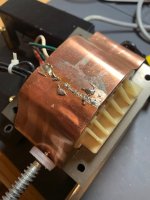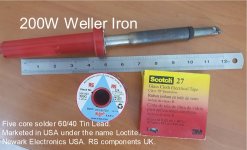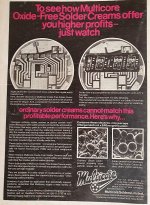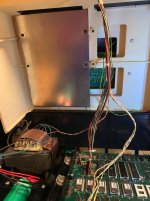For that thickness copper it requires a very large soldering iron, in the order of 200W. I use a 200W Weller.
Just some tips:
Don't use any liquid or additional fluxes, they are very corrosive and could get into the transformer windings and cause trouble later.
To help protect the surface of the transformer I would normally put a layer of Scotch 27 fiberglass tape over the surface under the copper band.
Copper (when up to temperature) is extremely easy to solder to, especially if you have proper 60/40 Multicore solder. No additional fluxes are required, the special flux is non corrosive even if left behind.
I can already see corrosion from the flux you added.
I never use liquid fluxes or added fluxes because all that is required is in the Multicore solder. The flux in it has been especially developed for electronic work and is completely inactive at temperatures below the soldering temperature.It also works well on copper, brass, tin plated steel, steel, etc. It does not go on to attack copper or other metals if left behind. Liquid fluxes can be very destructive in the long run to electronic parts and pcb's. Residual fluxes are the cause of items like meter movements, electronic delay lines, heads in disk drives small transformers with fine wire etc going open circuit due to corrosion near the solder terminations.
Flux pastes(creams) are needed for surface mount pcb work and all traces of that are better washed off.
One reason people reach for added fluxes is that they have never experienced a proper solder product with a multicore flux and struggle with surfaces that are oxidized and in desperation add flux. It is no drama if its a car radiator you are soldering up, you can add as much flux as you want, but with general electronics gear & components its a problem.
There are plenty of poor quality solders on the market with inferior flux sadly.
The point is though, any Blacksmith named Mr. Bloodaxe or Mr. Irongron from the year 1640 could make a 60/40 mixture of fairly pure Tin & Lead for you, that is not the problem.
All of the modern technology is in the Flux cores.
It took about 30 or 40 years of development for Multicore in the UK to create the flux in their 5 core solders, the recipe was basically complete by the early 1970's and like the formulations for capacitor electrolytes which are very complex, others copied it, with varying degrees of success & failure. This is also the type of solder used in the Avionics industry (luckily they have not been sucked into Lead free solder or I would never fly on a plane again). Once you have used it you will never reach for additional fluxes or any other solder product.
Multicore in the UK also pioneered the fluxes (solder creams) used to make early surface mount designs such as LED watches. See the attached advert from Wireless World 1978. Multicore were making 3 core solders in the early 1940's, even then they were thought to be superior.The company Multicore I think went on to become part of Henkel International.
Also, once your copper band is properly soldered, and you have cleaned it, you can apply a coat of varnish to it with a brush. I use marine spar varnish because it is resistant to cracking, it is very similar to transformer varnish. This preserves the appearance of the copper band and prevents corrosion of the surface, which can get unsightly with bare copper.





